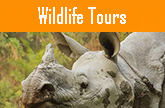Wildlife of Assam
Assam is the home of wildlife adventure replete with rich bio-diversity. The typical geographical and topographical features along with rivers, valleys and plains support a wide variety of flora and fauna. The habitat of Assam comprises tropical wet evergreen rain forest, low lying swamps, marshes, grasslands, wetlands, deciduous forest lands, sub tropical broadleaf forests, scrubs etc. There are 5 National Parks, 17 Wildlife Sanctuaries and 3 Bird Sanctuaries in the state. Assam serves a shelter to 180 species of mammals, 195 species of reptiles and more than 800 species of birds.
Kaziranga National Park
Internationally popular forest reserve and a UNESCO World Natural Heritage site, Kaziranga National Park is situated on the northern banks of the mighty river Brahmaputra, spreading wide on both the Golaghat and Nagaon districts of Assam. It covers an area of over 430 sq km. Its landscape is characterized by swamps, beels, tall elephant grass, flat grasslands with streams.
Kaziranga National Park supports a variety of flora and fauna. It is mainly the undistributed residence of the Great One horned Rhinoceros. It is also a home to a large population of Indian Elephant, Wild Water Buffalo, Swamp Deer, Indian Boson, Royal Bengal Tiger, Sloth Bear, Hog Deer, Leopard Cats, Otter, Hog Badger, Capped Langur, Hollock Gibbons, Wild Boar, Jackal, Pythons, Monitor Lizard and Fishing Cat etc. Small mammals like the rare Hispid Hare, Indian Gray Mongoose, Large Indian Civet, Small Indian Civet, Bengal Fox, Golden Jackal, Chinese Pangolin, Indian Pangolin, Hog Badger, Chinese Ferret Badger, Parti-colored Flying Squirrels etc. are also found here.
More than 500 species of birds have been recorded in Kaziranga National Park including 25 species of globally threatened category. Migratory birds like Lesser White Fronted Goose, Ferruginous Duck, Baer's Pochard Duck and Lesser Adjutant, Greater Adjutant, Black Necked Stork, Asian Openbill Stork etc. migrate to this park during the winter season every year. It is also a habitat of threatened species like Blyth's Kingfisher, White Bellied Heron, Dalmatian Pelican, Spot-billed Pelican, Nordmann's Greenshank, Black-Bellied Tern and other birds like the Eastern Imperial Eagle, Palla's Fish Eagle, Grey Headed Fish Eagle, Lesser Kestrel, Indian Vulture, Slender billed Vulture, Indian White-rumped Vulture, Swamp Francolin, Bengal Florican, Pale-Capped Pigeon, Black Breasted Parrotbill and Rufous vented Prinia etc.
It is also a homeland to the endangered Gangetic Dolphin. Besides there are more than 40 species of fishes and 42 species of reptiles are found in Kaziranga National Park. Rich in floral diversity, vegetation of Kaziranga National Park comprises of alluvial inundated grasslands, alluvial savannah woodlands, tropical moist mixed deciduous forests and tropical semi evergreen forests. The annual rainfall ranges 2220 mm. While winters are mild and dry, summers are hot and rainy with the monsoons at its peak stage during the months of July and August.
Recent Rhino population in Kaziranga National Park numbers to 2329. (March, 2013 census)
Recognitions:
* Kaziranga National Park was confirmed the status of a Reserve Forest in 1908.
* Declaration of Kaziranga National Park as a Wildlife Sanctuary was affirmed in 1950.
* It received official recognition as a National Park on 1st January, 1974.
* Kaziranga National Park was declared as a World Natural Heritage Site by UNESCO in 1985.
* Recognition of Kaziranga National Park as a Tiger Reserve was confirmed in 2006.
Activities:
* Sightseeing of wildlife
* Trekking and guided bird watching
* Elephant ride and Jeep safari
* Enjoying country boat ride
* Gangetic Dolphin viewing
* Tea Garden visit
* Coffee plantation visit
* Tribal village visit
* Temple visit
* Participation in ethnic feast
(Birds of Kaziranga National Park) (Mammals of Kaziranga National Park) (Reptiles of Kaziranga National Park)
Click for
Kaziranga National Park Best Selling Tour Packages
Manas National Park
Manas National Park is situated on the foothills of the Himalayas in the district of Barpeta. It is a famous Tiger Reserve of Assam. It encompasses an area of 519.77 sq km and is a home to many rare and endangered species of flora and fauna. It's rich bio-diversity and wealthy wildlife enhances the scenic beauty and glory of this park. Around 550 varieties of plant species identifies the rich flora of Manas National Park. It is a homeland to 60 species of mammals, 312 species of birds (26 species are endangered ones), 42 species of reptiles and amphibians, 54 species of fishes and 103 species of invertebrates.
Manas National Park is an ideal habitat to rare species such as One Horned Rhinoceros, Asian Elephant, Royal Bengal Tiger, Pygmy Hog, Hispid hare, Golden Langur, Bengal Florican, Gaur, Assam Roofed Turtle and Rat Snake. Leopard, Clouded Leopard, Himalayan Bear, Wild Boar, Sambar, Swamp Deer, Hog Deer are the common inhabitants of this park. Hundreds of migratory birds like Riverchats (White Capped Redstars) Forktails, Cormorants, and Ruddy Shelduck visit this park during the winter season.
According to March, 2013 census, Manas National Park shelters only 23 Rhinos.
Recognitions:
* Manas National Park was declared as a Reserve Forest in 1905.
* The park received the status of the Tiger Reserve in 1974.
* Declared as a World Natural Heritage Site by UNESCO in 1985.
* Its official recognition as a National Park was affirmed in 1990.
Activities:
* Elephant ride and Jeep safari
* Sightseeing of wildlife
* Trekking and guided bird watching
* Enjoying country boat ride
* Tea Garden visit
* Village visit
* River rafting
* Provision for angling (with permission)
(Birds' Check-list of Manas National Park)
Nameri National Park
Nameri National Park is situated in the foothills of Eastern Himalayas and covers an area of about 200 sq km, stretching along both banks of the Jia Bhoroli River in the district of Sonitpur. The park is identified with its rich diversity of flora and fauna. It consists of semi-evergreen vegetation, moist deciduous forests and open grasslands along with about 600 species of flora.
It is the famous resident place for Asian Elephants. It is also a homeland to Royal Bengal Tiger, Leopard, Clouded Leopard, Indian Bison, Gaur, Wild Boar, Sloth Bear, Himalayan Black Bear, Capped Langur, Indian Giant Squirrel, Pygmy Hog, Indian Wild Dog and Civet Cat. Various beautiful birds like White Winged Wood Duck, Great Pied Hornbill, Wreathed Hornbill, Black Stork, Ibis Bill, Blue-bearded Bee Eaters, Babblers, Plovers, Rufous Necked Hornbill etc. are also found here. The easiest means to explore the forest is on foot (accompanied by forest guard).
Recognitions:
* Nameri National Park was declared as a Reserve Forest in 1978.
* Its official recognition as a National Park was confirmed in 1998.
Activities:
* Trekking and guided bird watching
* River rafting across the Jia Bhoroli River
* Provision for angling (with permission)
(Birds' Check-list of Nameri National Park)
Dibru-Saikhowa National Park
Dibru-Saikhowa National Park is a famous bio-sphere reserve encompassing an area of about 340 sq km. One part of the area is wet land and the rest part comprises of grasslands, canebrakes and dense forests. Bounded by the Brahmaputra and Lohit rivers in the North and Dibru River in the South, this park is a homeland to more than 250 varieties of endemic, endangered and migratory birds.
Its main attractions are semi-wild Horse and White Winged Wood Duck. It is also a habitat to mammals like Asian Elephant, Leopard, Clouded Leopard, Sambar, Slow Loris, Indian Wild Water Buffalo, Capped Langur, Gangetic River Dolphin, Indian Wild Dog etc. The park is situated at an altitude of 118 meter above sea level. Annual Rainfall ranges from 2300 mm to 3800 mm.
Recognitions:
* Dibru-Saikhowa National Park was recognized as a Dibru Reserved Forest in 1890.
* It received preliminary confirmation as a Wildlife Sanctuary in 1986.
* Final affirmation of Wildlife Sanctuary was announced in 1995.
* The status of Biosphere Reserve was confirmed in 1997.
* Dibru-Saikhowa National Park received its final recognition as a National Park in 1999.
Activities:
* Trekking & guided bird watching
* Enjoying country boat ride
(Birds' Check-list of Dibru-Saikhowa National Park)
Orang National Park
Orang National Park is situated on the north bank of river Brahmaputra. The park comprises mainly of swampy grasslands, with numerous trees and tall grasses covering an area of 78.81 sq km. About 12 beels (wetlands) exist in the park which serves as a home to thousands of migratory birds in the winter season. The park is famous for its main attractions like Great Indian One-horned Rhinoceros, Asian Elephant, Sambar Deer, Barking Deer, Pangolin, Hog Deer, Civet Cat, Otters, Wild Boar etc. Birds including Pelican, Cormorant, Greylag, Gose, Large Whistling Teal, Greater Adjutant Stork, Kingfisher, and King Vulture are also found here in large numbers.
Rhino population in Orang National Park numbers to 100. (April, 2012 census)
Recognitions:
* Orang National Park was declared as a Wildlife Sanctuary in 1985.
* Its official recognition as a National Park was confirmed in 1999.
Activities:
* Elephant safari
* Sightseeing of wildlife
* Witnessing Elephant Training Camp
Pobitora Wildlife Sanctuary
Pobitiora Wildlife Sanctuary is situated in the Morigaon district. It is a major wildlife sanctuary in Assam covering an area of 38.8 sq kilometers out of which 15.9 sq kilometers area is the effective Rhino habitat. Pobitora Wildlife Sanctuary is mainly famous for its Great Indian One-horned Rhinoceros. Other important animals found in the sanctuary are Asiatic Buffalo, Leopard, Wild Boar, Civet Cat etc. Besides, 157 species of birds have been witnessed in the sanctuary so far.
According to April 2012 census, Pobitora Wildlife Sanctuary is a home to 93 Rhinos.
Recognitions:
* Pobitora received its official recognition as a Reserved Forest in 1971.
* Declaration of Wildlife Sanctuary was confirmed in 1987.
Activities:
* Elephant ride and Jeep safari
* Sightseeing of wildlife
(Birds' Check-list of Pobitora Wildlife Sanctuary)
Gibbon Wildlife Sanctuary
Gibbon Wildlife Sanctuary is an isolated protected area of evergreen forest located at Jorhat district of Assam. It comprises an area of 20.98 sq kilometers. Earlier Gibbon Wildlife Sanctuary was identified as Holongapar Forest. Later, the reserved forest was renamed as Gibbon since it is a home to India's only Gibbons - the Hoolock Gibbons. It is also an ideal habitat of North-East India's only nocturnal primate - the Bengal Slow Ioris. It is the only wildlife sanctuary in North-East India which harbours seven out of nine species of non human primates - Hollock Gibbon, Indian Slow Ioris, Capped Langur, Rhesus Macaque, Assamese Macaque, Pigtailed Macaque and Stump tailed Macaque. Other important mammals found here are Asian Elephant, Wild Boar, Leopard, Leopard Cat, Jungle Cat, Indian Fox, Civet Cat, Chinese Pangolin, Squirrel etc. A wide variety of Lizards, Python, Cobra and Turtles are found in the sanctuary. Important birds recorded here are Hornbill, Green Pigeon, Owl, Woodpecker, Dove, Bulbul, Black headed Oriole, Drongo, Barbet, Eagret etc.
Recogntions:
* Gibbon Wildlife Sanctuary received its official recognition as a wildlife Sanctuary in 1997.
Activities:
* Sightseeing of wildlife
Deepor Beel Bird Sanctuary
Deepor beel (meaning lake in local Assamese language), situated at the south-western part of Guwahati city is claimed to be the first bird sanctuary of Assam. It comprises an area of 40 sq kilometers of which 4.14 sq kilometers is declared as a bird sanctuary by the Govt. of Assam. Deepor beel is a permanent fresh water lake, located in a former channel of the mighty Brahmaputra River. The main sources of water are Basistha and Kalmini Rivers. At the time of flood in monsoon, the beel is approximately 4 meters deep while in the winter season, its level of depth decreases to just about 1 meter. The beel drains into Brahmaputra River through Khonajan channel, situated at a distance of 5 kilometes to the North.
Deepor Beel is gifted with a wide variety of flora and fauna. More than 220 species of birds have been recorded in the beel including 70 species of migratory birds. A record number of 19000 water birds have been witnessed in a single day count so far. Globally threatened birds like Greater Adjutant Stork, Lesser Adjutant Stork, Spotbilled Pelican, Baer's Pochard, Pallas' Sea Eagle etc are seen here. Common birds like Indian Pond Heron, Spot billed Duck, Common Teal, Bar-headed Goose, Little cormorant, Green Sand Piper, Common Sand Piper, Grey Headed Lapwing are found in the beel. A large number of migratory birds like Siberian Crane visit the beel in every winter season. Apart from these, Deepor beel harbours as many species as 20 amphibians, 18 snakes, 12 lizards and 6 turtle & tortoises.
Recognitions:
* Deepor beel was declared as a Bird Sanctuary by the state Govt. of Assam in 1989.
* Recognition as the only Ramsar Site in Assam was confirmed under the Ramsar Convention in 2002.
* Declaration of Deepor Beel as an Important Bird Area (IBA) was affirmed by Birdlife International.
Activities:
* Guided bird watching


















